Sites in Split: The Cellars of Diocletian's Palace
The cellars of Diocletian’s Palace are housed within the southern half of the palace. The floor plan showcases a mirror image of the emperor’s residence above as this substructure acted as supporting walls. The basement halls was the entranceway into the palace by sea via the Brass Gate and previously, when the sea reached the very walls of the palace, boats would be able to berth in front of the gate to drop off supplies or receive noble guests. As you pass through the basement towards the north you will reach the stairs that lead you directly up the Peristil Square.
During the time of the emperor, the basement was largely used for storage of foodstuff and wine. Actually, the remnant of a large press, which was used to turn the grapes into wine, is still visible today showcasing that Diocletian surely enjoyed a glass or two of his own Dalmatian wines down here.
As you meander through the underground, find the circular room and notice the impeccable acoustics; above, this room was the foyer to the emperor’s bedrooms and Diocletian would be warned if anyone was coming at night due to the echoes left by anyone passing through. Emperor Diocletian was very paranoid about being killed and had specifically requested this feature; apparently with success as he is the only Roman emperor to have died of natural causes.
After the fall of the Roman Empire and the consequent settlement of various civilizations, the basement was used for various purposes. In the Middle Ages it was inhabited, and eventually it turned into a water storage facility but through time, the basement got clogged up completely. As additional houses were built above the basement, they drilled holes into their floors in order to use the basement is a sewage tank and garbage dump.
Croatian architect and the country’s first conservator, Vicko Andrić who constructed the Riva harbor-front devoted his retirement to the conservation of Diocletian’s Palace and began an excavation of the cellars in the 1850’s. Andrić drained and cleaned the cellars and archeological discoveries are still being made to this day, particularly in the far corners of the basement. Amongst other finds, older remains from the previous civilization of Aspalatos were also found.
Today, the cellars are open to the public although the eastern part was only opened up in May 1995 after the celebration of the patron saint of Split, Sv. Dujan (St. Domnium). The main hall of the basement houses tacky souvenir stalls where tourists can buy a reminder of their stay in Split. The other areas of the basement reveal a labyrinthine room layout, ideal for an archeological discovery. The basement is also a popular venue for various events such as art exhibitions, weddings, and the International Flower Show held in May.
Sites in Split: Diocletian’s Palace Gates
The nucleus of Split is most definitely Diocletian’s Palace, a 1700-year-old Roman structure measuring approximately 160m by 190m. A gate or entranceway is located in the center along each of the four walls that lead down to the central square of Peristil, dividing the palace into four quarters.
Golden Gate
This gate was originally called Porta septemtrionalis but was renamed into Porta aurea (Golden Gate) by Venetians, which is what it is known as today.It is located on the northern wall of the palace adjacent to the Strossmayerov Park (Đardin) and the statue of Grgur Ninski. It is connected to a cardo, a north-south main street, leading to the central square of Peristil; this street is known as Dioklecijanova today (Diocletian’s Street).
The Golden Gate is the main entrance to the palace and was used by the emperor when he entered his new home for the first time on June 1st, 305 AD as he arrived from his nearby town of Salona (Solin). Its grand façade is decorated with niches where sculptures of four regional rulers once sat. The four rulers included Diocletian himself, his co-emperor and subordinate Maksimian, emperor and later son-in-law Galerius, as well as emperor and governor of Dalmatia Constantine Chlorus. Previously, there were octagonal towers on either side of the gate and later a large Benedictine convent, which was later commissioned as a military hospital. None of these structures exist today however, remains of the Benedictine convent can be seen nearby at the Chapel of Arnir featuring an altar slab and sarcophagus made by the early Renaissance sculptor and architect Juraj Dalmatinac.
The Golden Gate had double gates creating a Propugnaculum, a defense system or human trap where invaders would be captured between the outer and inner gates into an enclosure or courtyard measuring 9m by 9m. The inner gate was made of solid wood and the outer gate consisted of metal bars, which were lowered when invaders entered the enclosure.
Sitting above the gate is the 5th century Chapel of St. Martin, the patron saint of soldiers. This miniscule chapel measuring just 5 meters in width is one of the earliest Christian chapels anywhere and was built for the troops who guarded the gate. If you are lucky, you can access the chapel by a narrow stairway by turning right after passing through the gates and ring the doorbell of the Dominican convent. The nuns here look after the chapel and are happy to showcase its charming beauty and impressive history to visitors.
As you look upon the gate from the outer walls today, you can see that life still breathes in the palace and within the ancient walls themselves; notice the arches have been bricked and fitted with windows, laundry is drying, and a resident’s private terrace sits above the inner gate.
Brass Gate
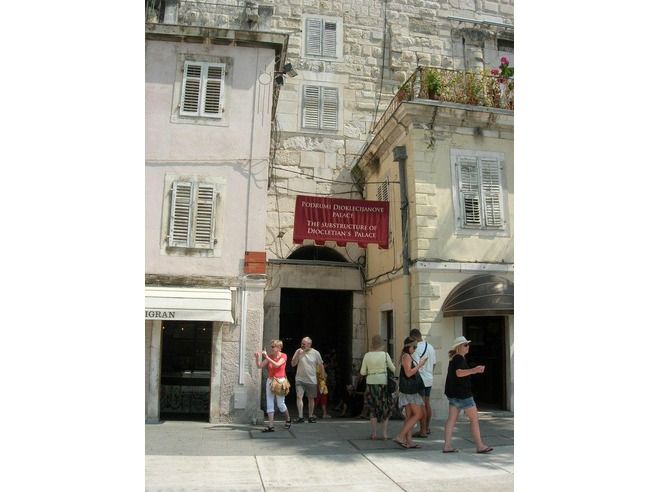
Image by members.virtualtourist.com
This gate was originally called Porta meridionalis but was renamed into Porta aenue (Brass Gate) by Venetians, which is what it is known as today. It is located on the southern wall of the palace, adjacent to the sea and popular Riva harbor-front promenade. It connects into the basement halls of the palace leading below the emperor’s imperial quarters up the stairs to the Peristil Square, and further down the cardo to the Golden Gate.
The Brass Gate is much smaller and simpler than the other gates and originally, there was no Riva and the sea reached the very walls of the palace. The Brass Gate was the entrance by sea into the palace. The gate was also dubbed the “safety gate” because it enabled the emperor and others to escape by sea in case of danger. It also acted as a service entrance for supplies that came by boat.
Today, the Brass Gate is the most popular passageway for tourists as it leads you to all the souvenir shops located in the basement halls. The basement halls showcase the substructure of Diocletian’s Palace consisting of many rooms and wall work as supporting walls for the emperor’s residents above. As you meander through the underground, find the circular room and notice the impeccable acoustics; above, this room was the foyer to the emperor’s bedrooms and Diocletian would be warned if anyone was coming at night due to the echoes left by anyone passing through. After the time of Diocletian, the basement was filled up with dirt and sewage but was excavated in the 1850's where they also discovered even older remains from the previous civilization of Aspalatos.
Silver Gate

Image by www.visitsplit.com
This gate was originally called Porta orientalis but was renamed into Porta argentea (Silver Gate) by Venetians, which is what it is known as today. It is located on the eastern wall of the palace, adjacent to main green market, Pazar and the church of St. Dominic. It connects to the decumanus, an east-west main street leading to the central square of Peristil and on to the Iron Gate, exiting onto the Pjaca Square.
Although less apparent today, the Silver Gate also had a Propugnaculum, a defense system or human trap where invaders would be captured between the outer and inner gates. The Silver Gate however, is not as richly decorated as the Golden Gate but you can vaguely spot the remains of the octagonal towers on either side of the gate.
Like three of the gates in the palace, the look-out corridor above the gate was transformed into a church in the 6th century dedicated to the gate’s patron Saint Apollinaire who, during the Early Christian period was a saint worshipped all over the Mediterranean. It was believed that the saint’s supernatural powers protected the city from invasions from the East.
The gate was bricked up during the Middle Ages for security reasons and later other structures covered the out walls and later a smaller opening directly next to the gate called the Venetian Gate was created to gain access to the palace. During World War II, the gate was heavily damaged and the Baroque church “Dušica” which was also incorporated within the gate walls was also destroyed. In the 1950’s, the gate underwent a thorough renovation and re-opened.
Directly outside the gate is the Church of St. Dominic, first mentioned in the 13th century but got its current structured in the 17th century and later it underwent an expansion in the 19th century. Within the church you will find a fascinating painting from the Middle Ages titled “Miracle in Suriano” by Palma il Giovane, a gothic crucifix, preserved wooden Baroque altars, an ancient organ, and the tomb of Arrigoni, the early 17th century bishop of Šibenik.
The most recent highlight of the Silver Gate was when Pope John Paul II paid a visit to Split in 2000; he passed through the gate in his “Popemobile” and driving along the wide decumanus, much like the emperor did in his chariot almost two millennia ago.
Iron Gate
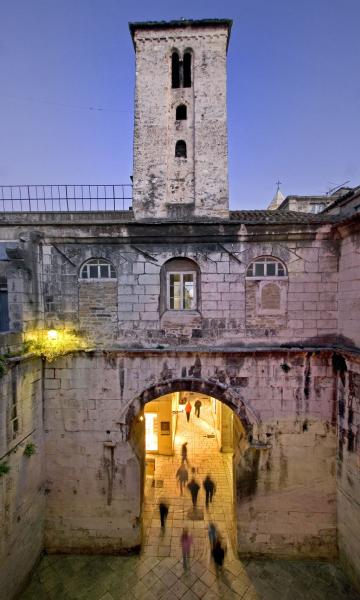
Image by www.visitsplit.com
This gate was originally called Porta occidentalis but was renamed into Porta ferrea (Iron Gate) by Venetians, which is what it is known as today. It is located on the western wall of the palace, at the exit to the popular Pjaca Square. It connects to the decumanus, an east-west main street leading to the central square of Peristil and on to the Silver Gate.
The Iron Gate is the most cluttered of the four gates as centuries of developments have been built around and Romans, Avars, Slavs, Italians and French have all left their mark here.
Clearly visible, the Iron Gate also had a Propugnaculum, a defense system or human trap where invaders would be captured between the outer and inner gates. This gate was the only free port of entry during the Middle Ages and therefore, the enclosure between the outer and inner gate served as a courtroom where the fate of those seeking refuge in the palace would be decided.
The early Christian Saint Teodor was the protector of the Iron Gate and in the 6th century a tower-like church was erected above the gate on the sentry corridor to honor him. Built in Romanesque style, its design is rather modest. The structure has two floors but you will notice three rows of windows; this was to provide an illusion of three floors.
An expansion of the church was made one millennium ago and with another tower, “Gospa Zvonik” or our Lady of the Bell Tower. It is an early-Romanesque tower topped with a gothic bell-tower. It has a little double arched window and a grand clock on its façade. The clock is captivating as it is divided into 24 parts instead of 12.
Sites in Split: Voćni Trg
The square of Trg Braće Radić, unofficially called Voćni Trg (meaning Fruit Square) by everyone was once the home of a bustling fruit market. Now a sprawling square of shops, cafés and street performers, it is centered around three main historical landmarks.
Built in the 15th century to protect the city from local revolts and Turkish raids is an octagonal Venetian tower and adjoining Castello to the south of the square.A passageway leads through the structure onto the Riva promenade and in this arched corridor you will find two etched Christian crosses on your right hand side. Legend says that you must point with your fingertips at each point of one cross and make a love-related wish with closed eyes. You’ll also need to make sure that when you do this, no one else is passing though the passage in either direction. For maximum effect, you should attempt to walk through the short passage with your eyes closed until you are under open skies again.

Across the tower to the north is the grand Milesi Palace built in the 17th century, showcasing a spectacular Baroque façade considered to be one of the best examples of this architectural era in Dalmatia. The palace is recognized for its charming arched shop windows on the ground floor.
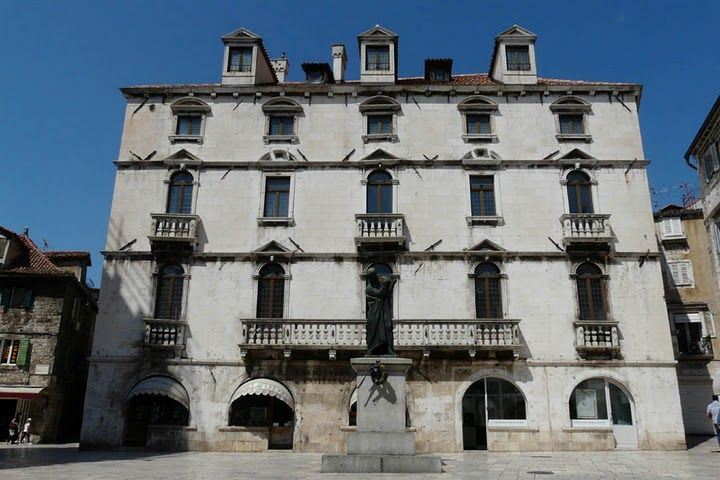
Marking the square is a statue of Marko Marulić, a 15th century poet and Christian humanist from Split who is known as the father of Croatian literature, the crown of the Croatian medieval age, and the father of the Croatian Renaissance. He is also depicted on the Croatian 500 Kuna banknote. The bronze statue is hand made by famed local sculptor and architect Ivan Meštrović. Meštrović has most of his works displayed in his previous home, now Meštrović Gallery in Split.
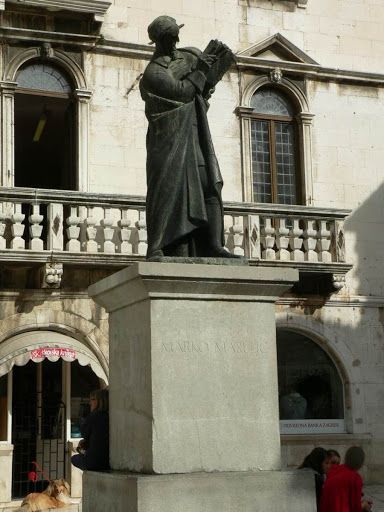
Voćni Trg also played an important role in Miljenko Smoje’s cult TV series, “Velo Misto.” The square’s cultural importance made it an ideal setting for filming many of the scenes depicting life in early 20th century Split.
On the square you will also find the upscale Croata shop, a tribute to the Croatian tie, a Marella high fashion store, a bank, a bookstore, and exclusive shoes in Karla. In the summer, souvenir stalls with live handicrafts and juice stands liven up the square.
Diocletian's Palace and its Most Visited Attractions
A little insight into the palace and its most visited attractions.
DIOCLETIAN'S PALACE
The Emperor, Diocletian constructed his retirement palace in about 300AD where he resided until his death. After his death, the palace became home to the various expelled emperors and their family. Eventually when the Avars and Slavs conquered the surrounding areas of Split, the city’s residents moved within the palace walls. More and more settlements were built within the palace and eventually the palace became the town itself. Today Diocletian’s Palace is considered one of the only cultural monuments in the world in which people still live. In the 17th century, a new defense system in the form of bastions was built around the palace by the famous Frenchman; A. Magli. Diocletian’s Palace is an example of the most magnificent Roman architecture on the Adriatic coast. It is important to mention that the palace also serves as a residential area today and is therefore open to all. Due to this, it is near impossible to control the flow of visitors to the site. There are many attractions within the palace, but the most viewed is the St. Duje Cathedral on the Peristyle square. Other popular sites are the Temple of Jupiter and the cellars of the palace. The narrow, crooked streets with various shops are also popular among tourists.

Aerial View of Diocletian's Palace
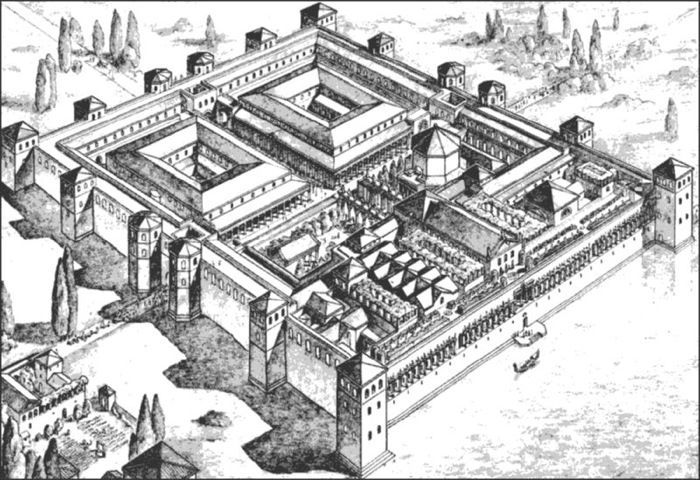
Drawing of the palace in its original plan
ST. DUJE (DOMNIUS) CATHEDRAL
The St. Duje Cathedral and bell tower is known as one of the oldest Catholic Cathedrals in the world and is located within the palace walls in the central square of Peristyle. The construction of this cathedral only began in the 13th century, long after the death of Emperor Diocletian as he was a persecutor of Christians. Ironically, this Cathedral was once the emperor’s mausoleum. The bell tower however, took about 300 years to construct. The cathedral has an octagon shape which is surrounded by a colonnade. Next to the entrance to the cathedral are is a black sphinx from 15 BC which was brought from Luxor in Egypt. In the cellar of the cathedral, tourists who enjoy historical religious artifacts can visit the treasury. Visitors can also climb to the top of the bell tower to enjoy 360 degree views of Split.
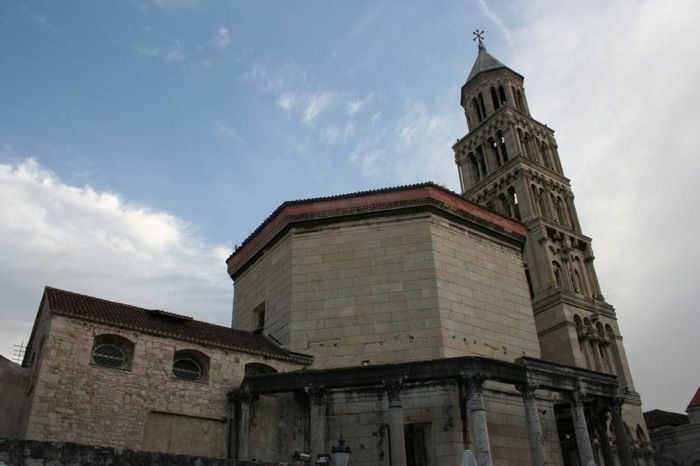
St. Duje's Cathedral and Bell Tower

Egyptian Sphinx
THE BASEMENT HALLS
The substructure of Diocletian’s Palace consists of many rooms and the wallwork as supporting walls for the emperor’s residents above. In the past, these rooms were of no use as they were under water. The seaside entrance to the palace allowed ships and boats to enter the through this gate, and anchor below the place and enter straight onto the Peristyle central square. Myths say that the persecuted Christians were left in this substructure in the small rooms, preventing the bodies from flowing out. In the 1850’s, architect Vicko Andric started a project which drained and cleaned the cellars of Diocletian’s Palace, and created a Riviera on the seaside front of the palace which is known as Riva today. Today the cellar is the main area for souvenir shops that lead to the stairs that go the Peristyle square and St. Duje’s cathedral. Other parts of the substructure are used as temporary art exhibitions or function spaces.
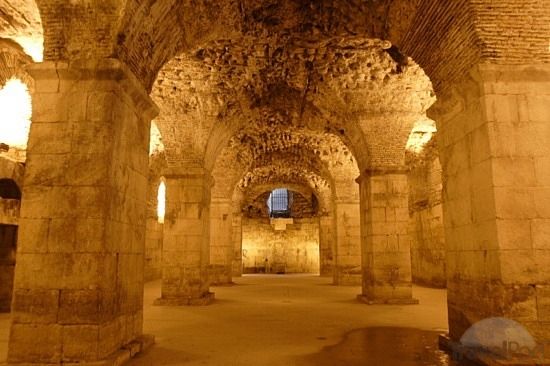
JUPITER'S TEMPLE
Jupiter was the name of Diocletian’s father and was also the highest Roman god. After the fall of the Roman Empire, the temple was converted into a Cathedral baptistery. Inside the small temple, there are two medieval stone coffins where the archbishops of Split, John and Luka are buried. Inside the temple there is a statue of Saint John made by the famous sculpture, Ivan Mestrovic. In the center of the temple there is a font basin which today is used as a wishing well as visitors throw coins in it. Originally, the temple never had a roof and this caused the rapid deterioration of the site due to environmental factors. The imposing arched ceiling has a series of face sculpured looking down on you. At the entrance of the temple, another Eqyptian sphinx can be found however, it has been vandalized and no longer has a head.
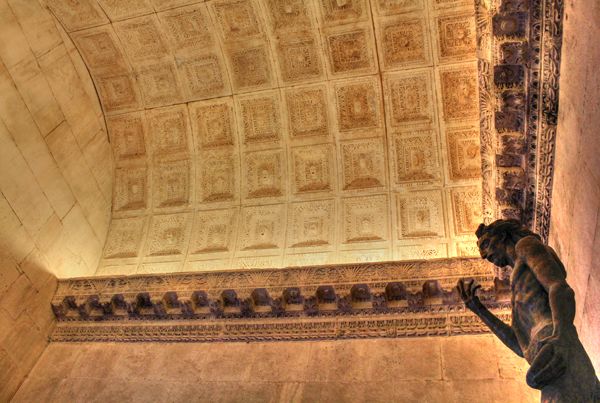
Interior pf Jupiter's Temple: Arched ceiling and statue of St. John
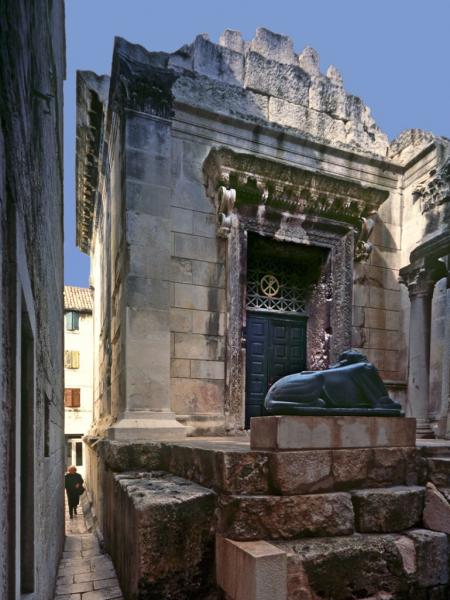
Jupiter's Temple with Headless Sphinx in Front
STATUE OF GRGUR NINSKI
The statue of Grgur Ninski, made my Ivan Mestrovic in 1929, is another well visited site for tourists. Previously, the statue was located in the central square of Peristyle but was moved in World War II, cut into three and dug underground to hide it from the occupying forces. It was re-erected outside the palace wall by the East, “Golden Gate” entrance. Grgur Ninski was the arch bishop of Split in the 10th century who also strongly opposed the Pope. Services were always held in Latin which was not understandable to the people of Croatia. Grgur Ninski then changed his services into the Croatian language which created more worship among the people as they understood their services and prayers. Some wearing has happened as it is believed that touching the toe of the statue brings luck. Over the years as more tourist visit the sight, it has been rubbed golden.
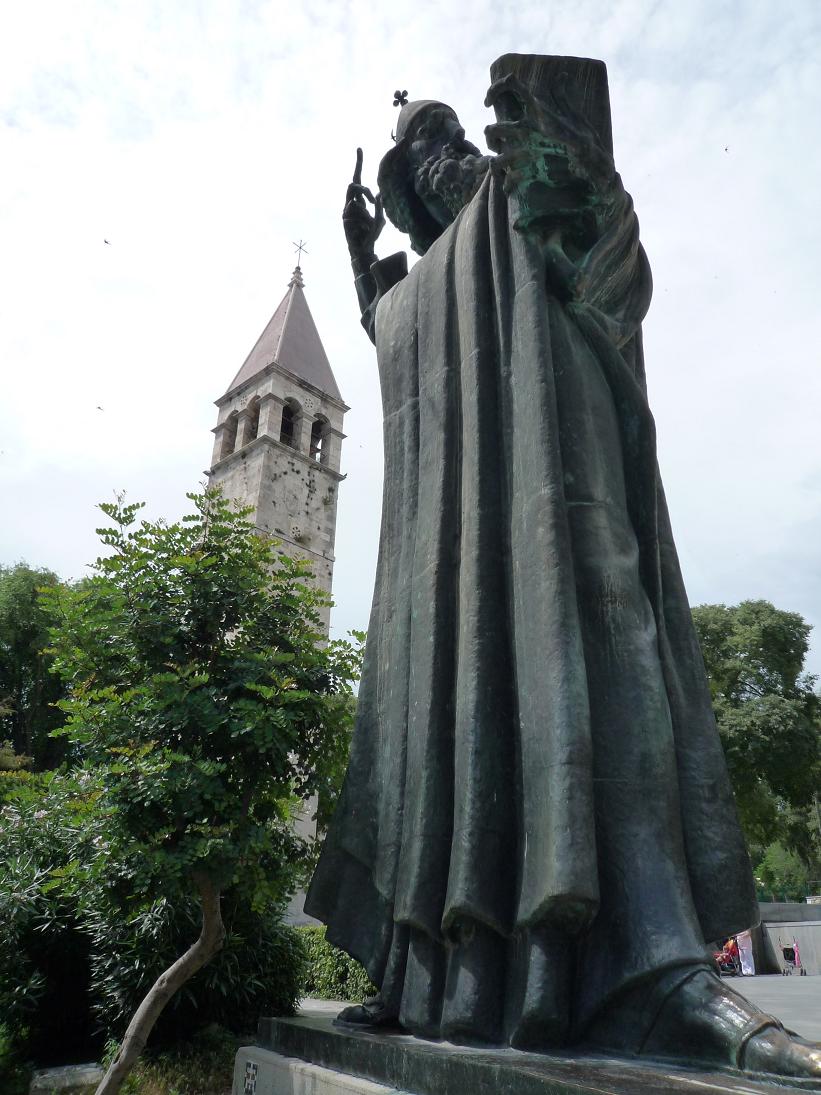
Statue of Grgur Ninski
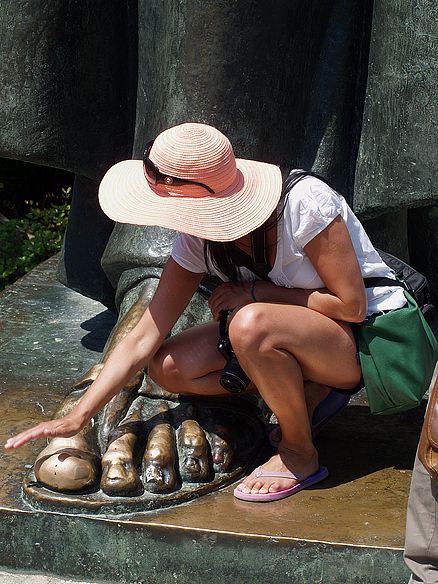
Make a wish!

